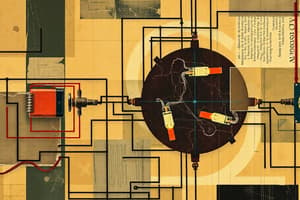Podcast
Questions and Answers
What happens in a series circuit if one component breaks?
What happens in a series circuit if one component breaks?
- The entire circuit continues to function.
- Only the broken component stops working.
- The current flow increases in the remaining components.
- The entire circuit stops working. (correct)
What defines a parallel circuit?
What defines a parallel circuit?
- Each component has a different voltage applied.
- The total resistance is equal to the sum of individual resistances.
- There is only one path for current to flow.
- All components are connected across each other's leads. (correct)
How is total resistance calculated in a parallel circuit?
How is total resistance calculated in a parallel circuit?
- By taking the average of all individual resistances.
- By measuring the voltage drop across each resistor.
- By simply adding all individual resistor values.
- By taking the reciprocal of the sum of the reciprocals of all resistors. (correct)
What is the relationship between total voltage and voltage drop in a series circuit?
What is the relationship between total voltage and voltage drop in a series circuit?
What characterizes direct current (DC)?
What characterizes direct current (DC)?
Which of the following statements is true for the current in a parallel circuit?
Which of the following statements is true for the current in a parallel circuit?
In a series circuit, how does total resistance change when additional resistors are added?
In a series circuit, how does total resistance change when additional resistors are added?
Which variable represents current in electrical calculations?
Which variable represents current in electrical calculations?
Flashcards
Series Circuit
Series Circuit
A circuit where the components are connected end-to-end in a line, forming only one path for current to flow.
Parallel Circuit
Parallel Circuit
A circuit with multiple paths for current flow, allowing current to split and recombine.
Total Resistance
Total Resistance
The total opposition to current flow in an electrical circuit.
Total Resistance in Series Circuit
Total Resistance in Series Circuit
Signup and view all the flashcards
Total Resistance in Parallel Circuit
Total Resistance in Parallel Circuit
Signup and view all the flashcards
Voltage Drop
Voltage Drop
Signup and view all the flashcards
Voltage Drop in Series Circuit
Voltage Drop in Series Circuit
Signup and view all the flashcards
Direct Current (DC)
Direct Current (DC)
Signup and view all the flashcards
Study Notes
Electricity: Series and Parallel Circuits
- Series Circuit: Current flows through all components in a single path. If one component fails, the entire circuit stops functioning. Components are connected end-to-end.
- Parallel Circuit: Current flows through multiple paths. Failure of one component does not affect the rest of the circuit. Components are connected across each other.
Circuit Differences
- Voltage (Series): Total voltage is the sum of individual voltage drops across each component.
- Voltage (Parallel): Voltage is the same across each component and equals the voltage source.
- Current (Series): Current is the same throughout the entire circuit.
- Current (Parallel): Total current is the sum of the individual branch currents.
- Resistance (Series): Total resistance is the sum of individual resistances.
- Resistance (Parallel): Reciprocal of total resistance is the sum of reciprocals of individual resistances; total resistance is less than the smallest individual resistance.
Calculating Circuit Components
- Voltage Drop: Decrease in voltage across a component due to resistance.
- Ohm's Law: Voltage (V) equals current (I) times resistance (R). (V = IR)
- Total Resistance (Series): RT = R₁ + R₂ + R₃...
- Total Resistance (Parallel): 1/RT = 1/R₁ + 1/R₂ + 1/R₃...
Circuit Types: Symbols and Labels used
- Direct Current (DC): Current flows in one direction.
- Alternating Current (AC): Current changes direction periodically.
- Voltage: Symbol (V), Unit (Volts)
- Resistance: Symbol (R), Unit (Ohms)
- Current: Symbol (I), Unit (Amps)
Additional Notes
- Circuit Failure: In a series circuit, if one component fails, the entire circuit stops working. In a parallel circuit, failure of one component doesn't affect others.
- Multimeter Usage: Used to measure voltage drops.
Studying That Suits You
Use AI to generate personalized quizzes and flashcards to suit your learning preferences.




